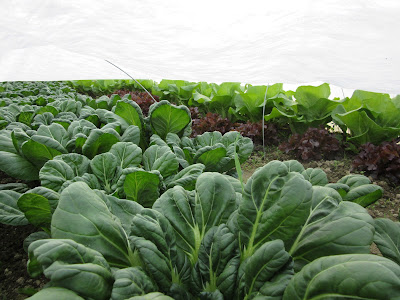Cool Spring
We spend much of our time transplanting May-June. Almost every minute actually, even though there are loads of other tasks to be done as well. Before we plant, we dunk each flat into a tank of "nutrient tea". It's a mix of worm castings, crab shell flour, humates and coral. It smells a bit like a fishy ocean, but the plants love it. Apparently so does Chicken.
Typically in the spring we cover plants after we transplant them. Sometimes it's to keep them warm and other times it's to keep pesky bugs off of them. Chicken likes to use it as his treadmill.
Under this fabric, the plants stay cozy and bug free. It is labor intensive to cover plants (especially on windy days). I admit it is not my favorite farm tasks, but the end result is rewarding. This tat soi, lettuce, chinese cabbage and pac choi are looking very delicious! You will find some of them in your pick up this week!
This pigs are also enjoying their greens! We let them out to pasture this weekend and they had a ball. Rooting, running and chomping on grass. They even had a romp out of the fence...hopefully that will not be the norm for them this summer!
We are excited for this week's bounty even thought it has been tremendously cool and wet. Time to target your inner rabbit and nosh on some spring greens!
This week's Bounty: lettuce mix, head lettuce, spinach, tat soi, pac choi, scallion, chive, asparagus and parsnips
Farmer's Table:
Marinated pork chop fried rice with carrots, scallions and parsnips
LRF grass-fed Beef and Parsnip stew
Cajun pork roast with sauteed sweet peppers (some available for sale in the freezer!)
Pork stock (made from the roast bone) with rice and spinach
Dung Po (pork belly) spinach, scallion with rice pasta and homemade plum sauce
LRF grass-fed beef burgers with fresh lettuce and homemade pickles













